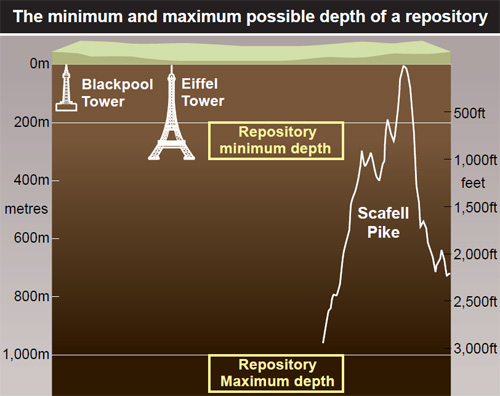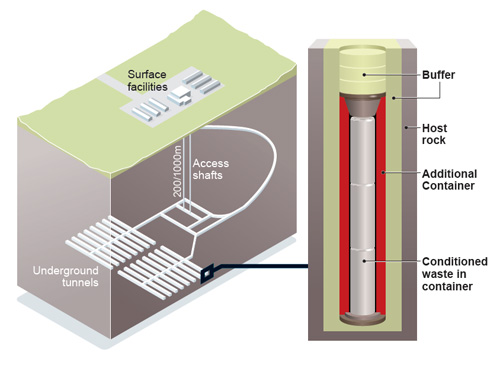Background information
Why geological disposal?
An independent committee of experts, the Committee on Radioactive Waste Management (CoRWM) recommended that geological disposal was the best available long-term approach compared to other ways of managing higher activity radioactive waste.
 Higher activity waste is currently stored above ground, the majority of it at Sellafield. This waste decays over time but some of it remains hazardous for many thousands of years.
Higher activity waste is currently stored above ground, the majority of it at Sellafield. This waste decays over time but some of it remains hazardous for many thousands of years.
The Committee on Radioactive Waste Management said geological disposal would be safer in the longer term than storage above ground e.g. because of the risk of terrorism.
They also said that we cannot rely on societies hundreds or thousands of years from now to manage these wastes safely above ground.
The Committee on Radioactive Waste Managementís recommendations received wide ranging support. Geological disposal is also the preferred approach in most other countries with nuclear waste.
However, some people and organisations are not convinced about the long term safety of geological disposal and oppose having an underground repository. These organisations include Greenpeace, Friends of the Earth and Radiation Free Lakeland.
What is geological disposal?

The Government says geological disposal involves placing the waste deep underground in a purpose built facility, called a geological disposal facility or a repository, leaving the waste there forever once the facility is closed.
It is based on the idea that radiation can be contained for extremely long periods by a combination of engineered underground structures and the surrounding rocks. This is called a multi-barrier approach. While the waste is in the facility, the level of radioactivity will reduce over time.
What might a repository look like?
A repository would be located between 200 and 1000 metres underground.
The underground facilities could be somewhere between 6 km≤ and 23 km≤ (2.5 and 9 square miles) in size, depending on the type of rock, and how much and what kind of waste would be placed into the repository. (The higher figure was originally given as 25km2, but the Nuclear Decommissioning Authority has done further work to look at vault dimensions and has now revised this figure.)
This would be between approximately one and four times the size of the Sellafield site. The amount of rock that would need to be excavated to create the facility is similar to what was removed during the building of the Channel Tunnel.

There would also be surface facilities with buildings such as administration offices, workshops and possibly a waste packaging facility for waste created by any new nuclear reactors. It is estimated these facilities would be about 1 km≤.
The underground facilities would be accessed through sloping tunnels and vertical shafts.
The Nuclear Decommissioning Authority, which is responsible for implementing geological disposal, says surface facilities could either be above the underground facilities or up to 10km away, possibly further.
The diagrams on this page are for indicative purposes only.
> View next page 'International experience'

